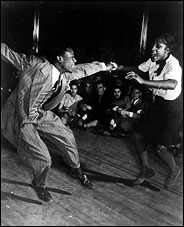
Music and entertainment play a minor, yet significant role in Petry’s The Street–where, as Lutie notes, they provide a world of “rainbow-colored lights.” They were also, of course, a major part of Harlem social and business life in the 1920s, 1930s, and 1940s when the neighborhood was home to several ballrooms and auditoriums, as well as to numerous nightclubs and bars, that were vital to the explosive emergence of “swing” in the late thirties and then to the less popular, but equally influential bebop revolution of the mid to later forties.

It’s helpful in considering Petry’s novel and its representation of Harlem to have a sense of how important these institutions were to the neighborhood’s life. During the 1920s, the most famous nightclubs in Harlem–The Cotton Club and Small’s–catered to a white clientele. But during the Depression and the 1940s, there were several large venues, mainly owned by white entrepreneurs and gangsters, that proved hugely successful in providing entertainment venues to the full range of Harlem’s African-American community. By admitting big crowds for a relatively low entry fee, these giant clubs offered affordable luxuries for many ordinary Harlemites. They were also proving grounds for a large community of professional musicians, out of which a number of virtuosi rose to prominence, and the environment where equally virtuoso dancers created the Lindy Hop.
The Casino of The Street, where Boots plays and Lutie sings, is probably a reference to the Harlem Renaissance Casino–a massive entertainment complex, occupying one side of 7th avenue between 137th and 138th streets, built and, until the later 1930s, operated by West Indian immigrants. In the depths of the Depressions, the owners, who are said to have been followers of Marcus Garvey’s black nationalism, were forced to sell out to a new, white owner.
The Casino was an important entertainment venue during the twenties–when it was a gathering spot for the Harlem Renaissance elite–and thirties. (Among its other services, it hosted a world champion basketball team–the “Rens”.) The building still exists, but fell into disuse and decay decades ago. Spike Lee made it the setting for the hellish crack den in Jungle Fever. You can see some striking photos of its current state of disrepair here.
During the Depression and the 1940s, however, the Renaissance Casino was overshadowed by the famed Apollo Theater and the legendary Savoy Ballroom. (For more info on the Savoy, see this site and this article.) These were the venues were Harlem audiences encountered the major acts of the day, especially the big swing bands and the most popular African-American singers. Cab Calloway sang at the Savoy, as did Billy Eckstine. Ella Fitzgeraldwas famously discovered there.


As you consider Harlem of the 1940s and the way Petry envisioned it, it may be helpful to keep these locations in mind. What does music, dance, and entertainment mean for Lutie–and for Petry? Why do both Lutie and Boots register discontent at the thought that audiences don’t listen to their music? Why does Lutie repeatedly note the snatch of unrehearsed tune two musicians work out while Boots tells her she won’t be paid? And why might Petry have featured the Casino rather than the more prominent nitespots of the moment–the Savoy and the Apollo? Does any of this help us to understand how she views Harlem, its social life, and the opportunities that life presents?
